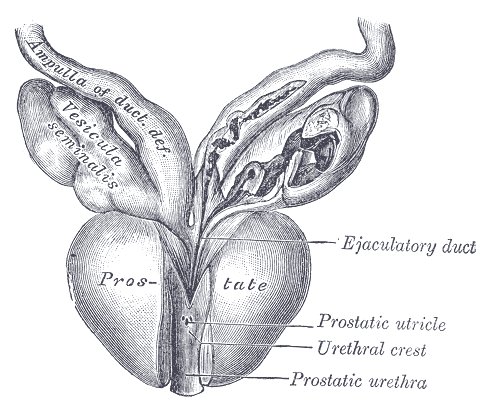WBR0506: Difference between revisions
Jump to navigation
Jump to search
No edit summary |
No edit summary |
||
| Line 21: | Line 21: | ||
|SubCategory=Reproductive | |SubCategory=Reproductive | ||
|Prompt=A 60-year-old patient comes to the outpatient clinic complaining of increased urination throughout the night and difficulty starting and stopping the stream of urine. He was diagnosed with hypertension 10 years ago, and is currently taking amlodipine. His vitals are: 67 pulse/min, 16 respirations/min, blood pressure 135/85mmHg and temperature 37C. His physical exam is unremarkable. The patient’s primary care physician orders a PSA (prostate-specific antigen), which is increased. Which of the following is true about the most likely diagnosis causing this patient’s symptoms? | |Prompt=A 60-year-old patient comes to the outpatient clinic complaining of increased urination throughout the night and difficulty starting and stopping the stream of urine. He was diagnosed with hypertension 10 years ago, and is currently taking amlodipine. His vitals are: 67 pulse/min, 16 respirations/min, blood pressure 135/85mmHg and temperature 37C. His physical exam is unremarkable. The patient’s primary care physician orders a PSA (prostate-specific antigen), which is increased. Which of the following is true about the most likely diagnosis causing this patient’s symptoms? | ||
|Explanation= | |Explanation=Beningn prostatic hyperplasia (BPH) is common in men older than 50 years old. Clinically it presents with increased frequency of urination, nocturia, difficulty starting and stopping the stream of urine, and dysuria. It can lead to distention and urinary bladder hypertrophy, hydronephrosis, and subsequent urinary tract infections. It is not considered a premalignant lesion. Microscopically the gland presents hyperplasia, not hypertrophy. Its etiology may be due to an age-related increase in estradiol and DHT. It is characterized by a nodular enlargement of the peri-urethral, which include the lateral and middle lobes which compress the urethra. It causes an increase in the free prostate-specific antigen (PSA). Treatment: arantagonists (terazosin, tamsulosin), which cause relaxation of smooth muscle; finasteride. | ||
ADC | Prostatic cancer it is commonly caused by adenocarcinoma (ADC), which incidence increases with age. Anatomically it is commonly located in the posterior lobe or peripheral zone, therefore accesible to the digital rectal examination of the prostate gland, which is felt as a hard nodule. Prostatic acid phosphatase (PAP) and PSA are used as tumor markers (increase in total PSA, with decrease in free fraction of PSA). Lately it can cause osteoblastic metastases which can be presented as: lower back pain and an increase in serum alkaline phosphatase and PSA. | ||
of the prostate gland | <font color="MediumBlue"><font size="4">'''Educational Objective:'''</font></font> | ||
# BPH is frequently located in the periurethral lobes causing urinary obstructive symptoms. It increases free PSA | |||
lower back pain and an | # Prostatic cancer is frequently located in the posterior lobe accesible by DRE. It increases total PSA, but decreases free PSA | ||
<br>'''References:''' First Aid 2013 reproductive chapter | |||
[[File:Gray1153.png|center]] | [[File:Gray1153.png|center]] | ||
|AnswerA=Prostatic cancer is preceded by benign prostatic hypertrophy | |AnswerA=Prostatic cancer is preceded by benign prostatic hypertrophy | ||
Revision as of 20:22, 24 September 2013
| Author | [[PageAuthor::Gonzalo A. Romero, M.D. [1]]] |
|---|---|
| Exam Type | ExamType::USMLE Step 1 |
| Main Category | MainCategory::Pathology |
| Sub Category | SubCategory::Reproductive |
| Prompt | [[Prompt::A 60-year-old patient comes to the outpatient clinic complaining of increased urination throughout the night and difficulty starting and stopping the stream of urine. He was diagnosed with hypertension 10 years ago, and is currently taking amlodipine. His vitals are: 67 pulse/min, 16 respirations/min, blood pressure 135/85mmHg and temperature 37C. His physical exam is unremarkable. The patient’s primary care physician orders a PSA (prostate-specific antigen), which is increased. Which of the following is true about the most likely diagnosis causing this patient’s symptoms?]] |
| Answer A | AnswerA::Prostatic cancer is preceded by benign prostatic hypertrophy |
| Answer A Explanation | [[AnswerAExp::Incorrect. See overall explanation]] |
| Answer B | AnswerB::Prostatic cancer increases both total PSA and free PSA |
| Answer B Explanation | [[AnswerBExp::Incorrect.See overall explanation]] |
| Answer C | AnswerC::Benign prostatic hyperplasia is localized frequently in the posterior lobe of the prostate |
| Answer C Explanation | [[AnswerCExp::Incorrect.See overall explanation]] |
| Answer D | AnswerD::Prostatic cancer is localized frequently in the lateral lobes of the prostate |
| Answer D Explanation | [[AnswerDExp::Incorrect.See overall explanation]] |
| Answer E | AnswerE::Benign prostatic hyperplasia increases free PSA |
| Answer E Explanation | [[AnswerEExp::Correct.See overall explanation]] |
| Right Answer | RightAnswer::E |
| Explanation | [[Explanation::Beningn prostatic hyperplasia (BPH) is common in men older than 50 years old. Clinically it presents with increased frequency of urination, nocturia, difficulty starting and stopping the stream of urine, and dysuria. It can lead to distention and urinary bladder hypertrophy, hydronephrosis, and subsequent urinary tract infections. It is not considered a premalignant lesion. Microscopically the gland presents hyperplasia, not hypertrophy. Its etiology may be due to an age-related increase in estradiol and DHT. It is characterized by a nodular enlargement of the peri-urethral, which include the lateral and middle lobes which compress the urethra. It causes an increase in the free prostate-specific antigen (PSA). Treatment: arantagonists (terazosin, tamsulosin), which cause relaxation of smooth muscle; finasteride.
Prostatic cancer it is commonly caused by adenocarcinoma (ADC), which incidence increases with age. Anatomically it is commonly located in the posterior lobe or peripheral zone, therefore accesible to the digital rectal examination of the prostate gland, which is felt as a hard nodule. Prostatic acid phosphatase (PAP) and PSA are used as tumor markers (increase in total PSA, with decrease in free fraction of PSA). Lately it can cause osteoblastic metastases which can be presented as: lower back pain and an increase in serum alkaline phosphatase and PSA. Educational Objective:
 Educational Objective: |
| Approved | Approved::No |
| Keyword | WBRKeyword::Prostate cancer, WBRKeyword::BPH |
| Linked Question | Linked:: |
| Order in Linked Questions | LinkedOrder:: |